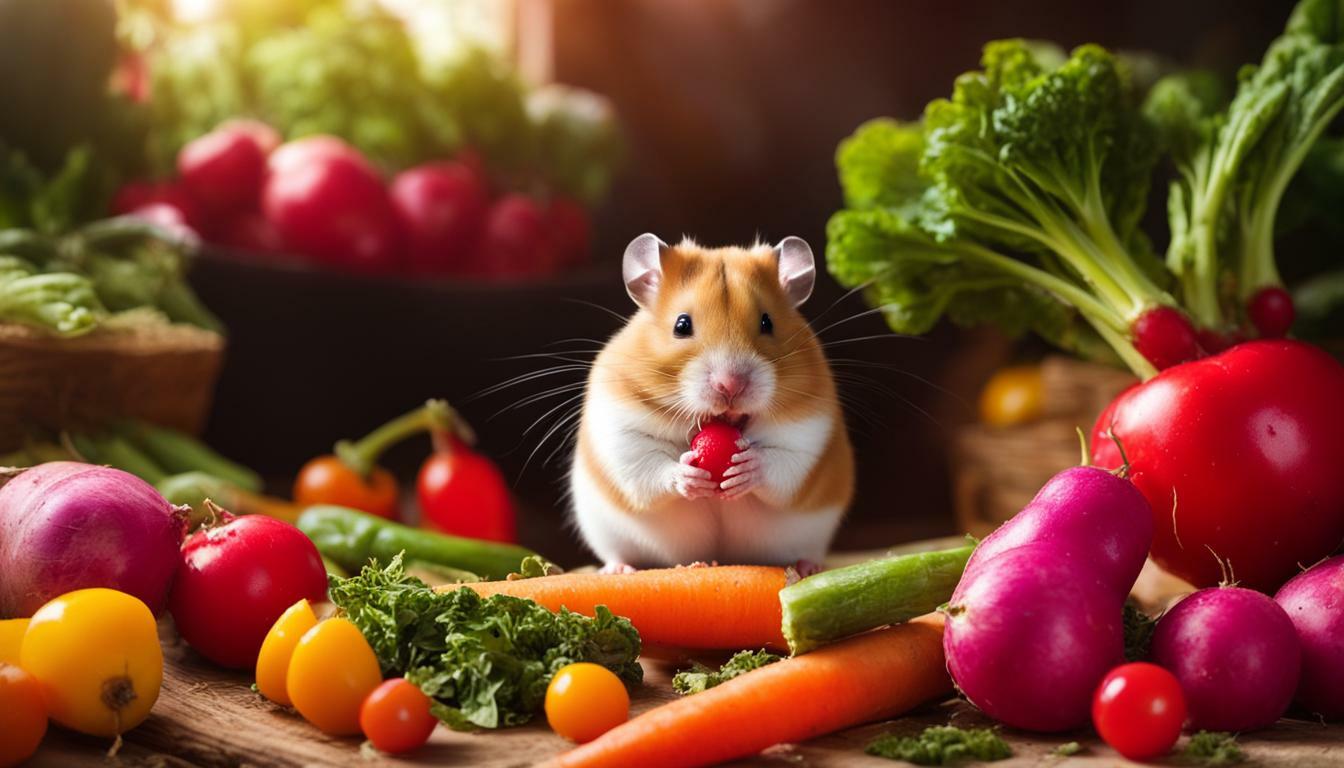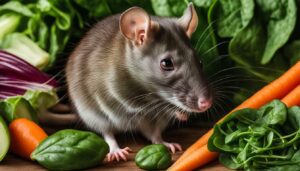Hamsters are curious eaters, and as a responsible owner, it’s important to know what foods are safe for them to consume. In this section, we will explore whether hamsters can safely eat radishes and discuss their dietary needs.
Key Takeaways:
- Radishes can be safely consumed by Syrian and Roborovski hamsters in moderation.
- Dwarf hamsters may need to avoid radishes due to their tendency to develop diabetes.
- It’s best to feed hamsters only the radish root and avoid the leaves and seeds.
- Syrian and Roborovski hamsters can have 1-3 small slices of radish weekly.
- Dwarf hamsters should be given only a small slice or less as an occasional treat.
Understanding a Hamster’s Diet
Hamsters are omnivores and require a well-balanced diet that includes a mix of fresh fruits, vegetables, and high-quality hamster pellets. When it comes to vegetables, it’s important to choose safe options that provide essential nutrients without causing any harm to your furry friend.
Safe Vegetables for Hamsters:
- Leafy Greens: Dark, leafy greens such as spinach, kale, and romaine lettuce are excellent choices. They are rich in vitamins and minerals that support your hamster’s overall health.
- Asparagus: Asparagus is a nutritious option that provides fiber, vitamins, and antioxidants. It can be given to hamsters in small amounts.
- Carrots: Carrots are a popular vegetable among hamsters. They are a great source of beta-carotene and can be given as a treat in moderation.
While hamsters can eat radishes, they should be given in moderation. Radishes are high in B vitamins, zinc, and calcium, which are beneficial for hamsters. However, they also contain sugar and a little bit of salt. Syrian and Roborovski hamsters can safely enjoy 1-3 small slices of radish weekly, while dwarf hamsters should be given only a small slice or less as an occasional treat. It’s important to only feed the radish root and avoid the leaves and seeds.
When feeding radishes or any other vegetables to your hamster, it’s crucial to monitor their cage for any signs of bacterial or fungal growth. Keep their living area clean and remove any uneaten food promptly. Remember that radishes are not nutrient-dense enough to be a regular part of your hamster’s diet, so it’s always a good idea to offer a variety of safe vegetables to ensure they receive a balanced diet.
| Vegetable | Portion Size | Frequency |
|---|---|---|
| Radish | 1-3 small slices | Weekly |
| Leafy Greens | Small portions | Daily |
| Asparagus | Small amounts | Occasional treat |
| Carrots | Small portions | Occasional treat |
Nutritional Benefits of Radishes for Hamsters
Radishes are high in B vitamins, zinc, and calcium, which can support your hamster’s overall health when included as part of a balanced diet. These nutrients are essential for proper growth, energy production, and bone health in hamsters. Additionally, radishes are low in calories and fat, making them a healthy option for your furry friend.
However, it’s important to feed radishes to your hamster in moderation. While they offer nutritional benefits, radishes also contain sugar and a small amount of salt. Too much sugar can lead to weight gain and dental issues in hamsters, while excessive salt intake can disrupt their electrolyte balance.
If you have a Syrian or Roborovski hamster, you can offer them 1-3 small slices of radish weekly. Make sure to wash the radish thoroughly and remove any dirt or pesticides before feeding it to your pet. Dwarf hamsters, on the other hand, may need to skip radishes due to their susceptibility to diabetes. If you still want to provide them with a small treat, offer them a tiny slice or less occasionally.
When feeding radishes to your hamster, it’s crucial to monitor their cage for any signs of bacterial or fungal growth. Radishes, like other vegetables, can spoil quickly and attract harmful microorganisms. Remove any uneaten radish from the cage promptly to maintain a clean and hygienic environment for your hamster.
| Hamster Breed | Recommended Radish Portion |
|---|---|
| Syrian | 1-3 small slices per week |
| Roborovski | 1-3 small slices per week |
| Dwarf | A small slice or less as an occasional treat |
While radishes can be a part of your hamster’s diet, it’s important to remember that they are not nutrient-dense enough to be a regular food option. There are other treats available that can provide more nutritional value, such as leafy greens (like spinach or kale), small amounts of asparagus, or even a tiny piece of potato. Offering a variety of safe vegetables in moderation will help ensure your hamster receives a well-rounded and healthy diet.
Hamster Breeds and Radish Consumption
While some hamsters can enjoy radishes, it’s important to consider the breed and their specific dietary requirements. Syrian and Roborovski hamsters can safely consume a small amount of radish as part of their diet, but dwarf hamsters may need to avoid radishes due to their susceptibility to diabetes. It’s crucial to prioritize the health and well-being of your furry friend by understanding their dietary needs.
Radishes in a Hamster’s Diet
Radicchio is a flavorful vegetable that is part of the radish family. Its unique taste and texture provide a refreshing change in a hamster’s diet. The high water content of radicchio helps to keep your hamster hydrated, while the B vitamins, zinc, and calcium present in radicchio provide essential nutrients for their overall health. However, it’s important to remember that radishes also contain sugar and a little bit of salt, so moderation is key.
When offering radishes to your hamster, it’s best to stick to the root portion and avoid the leaves and seeds. The root is the most nutrient-dense part and poses fewer risks of digestive issues. Syrian and Roborovski hamsters can be given 1-3 small slices of radish on a weekly basis, while dwarf hamsters should be given only a small slice or less as an occasional treat. Remember to observe your hamster’s behavior and adjust the serving size accordingly.
Monitoring for a Healthy Environment
As with any new addition to your hamster’s diet, it’s important to monitor their well-being. When feeding radishes, pay close attention to your hamster’s cage to prevent any potential bacterial or fungal growth. Regularly clean and inspect their living area, removing any uneaten portions of radish promptly to maintain a clean and healthy environment.
| Hamster Breed | Recommended Radish Consumption |
|---|---|
| Syrian Hamster | 1-3 small slices weekly |
| Roborovski Hamster | 1-3 small slices weekly |
| Dwarf Hamster | Small slice or less as an occasional treat |
Considering Better Treat Options
While radishes can be included in a hamster’s diet, they should be viewed as an occasional treat rather than a staple food. There are other vegetables that can provide more nutritional benefits for your hamster. Leafy greens such as spinach or kale, as well as crunchy vegetables like asparagus and small amounts of potato, can be healthier alternatives for your furry friend.
By understanding the specific needs of your hamster breed and offering a well-balanced diet, you can ensure that your pet is happy, healthy, and enjoying a variety of nutritious treats.
Moderation for Dwarf Hamsters
Dwarf hamsters are prone to developing diabetes, so it’s best to limit or avoid feeding them radishes to prevent any potential health issues. While radishes offer certain nutritional benefits, such as being high in B vitamins, zinc, and calcium, they also contain sugar and a little bit of salt. These factors make radishes less suitable for dwarf hamsters, whose delicate health requires careful attention to their diet.
If you have a dwarf hamster, it’s advisable to focus on other safe vegetable options that can provide necessary nutrients without the potential risks associated with radishes. Leafy greens, such as spinach or kale, can be excellent choices to supplement their diet. Additionally, asparagus or small amounts of potato can be given as occasional treats to add some variety to their meals.
When feeding radishes to other hamster breeds, like Syrian and Roborovski, it’s important to do so in moderation. These hamsters can enjoy a small amount of radish as part of their diet, typically 1-3 small slices per week. However, it’s crucial to remember that radishes are not nutrient-dense enough to be a regular staple food, so it’s best to offer them as an occasional treat rather than a primary source of nutrition.
| Hamster Breed | Recommended Radish Intake |
|---|---|
| Syrian Hamsters | 1-3 small slices per week |
| Roborovski Hamsters | 1-3 small slices per week |
| Dwarf Hamsters | Only a small slice or less as an occasional treat |
As with any food given to your hamster, it’s important to monitor them for any signs of digestive discomfort or adverse reactions. Additionally, be diligent in keeping their cage clean and regularly checking for any bacterial or fungal growth, as radishes can be prone to spoilage. By following these guidelines and providing a balanced diet, you can ensure the health and well-being of your furry friend.
The Right Amount of Radish for Syrian and Roborovski Hamsters
Syrian and Roborovski hamsters can have 1-3 small slices of radish per week to add some variety to their meals. Radishes, with their crunchy texture and slightly spicy flavor, can be a delightful treat for these small pets. However, it’s crucial to remember that radishes should only be given in moderation as part of a balanced diet.
Radishes provide several nutrients that can benefit hamsters, including B vitamins, zinc, and calcium. However, they also contain natural sugars and a small amount of salt. This is why it’s important to limit the amount of radish given to your hamster, especially if they are prone to health issues such as diabetes, as is the case with dwarf hamsters.
When offering radishes to your hamster, it’s best to stick to the root portion and avoid the leaves and seeds. The root is where most of the nutrients are concentrated, making it the safest and most beneficial part for your furry friend. Ensure that the radish slices are small enough for your hamster to handle comfortably.
| Hamster Breed | Frequency of Radish |
|---|---|
| Syrian Hamsters | 1-3 small slices per week |
| Roborovski Hamsters | 1-3 small slices per week |
| Dwarf Hamsters | A small slice or less as an occasional treat |
It’s essential to monitor your hamster after introducing radishes into their diet. Watch for any signs of digestive discomfort or adverse reactions. Additionally, keep a close eye on your hamster’s cage to prevent bacterial or fungal growth, which can occur if any uneaten radish is left behind. Maintaining a clean and hygienic environment is crucial for your hamster’s overall well-being.
While radishes can be a tasty addition to your hamster’s diet, it’s important to remember that they should only be given as an occasional treat. Radishes are not nutrient-dense enough to be a regular part of their meals. Instead, you can opt for other safe vegetable options such as leafy greens, asparagus, or small amounts of potato to provide a balanced and varied diet for your furry friend.
Proper Preparations for Feeding Radishes
Before offering radishes to your hamster, make sure to wash them thoroughly and remove any leaves or seeds. Radishes are often treated with pesticides and chemicals, so it’s essential to clean them to ensure the safety of your furry friend. Pesticide residue can be harmful to hamsters and may lead to various health issues. Additionally, removing the leaves and seeds is crucial as they can be difficult for hamsters to digest and may cause discomfort or blockages in their digestive system.
Once the radishes are cleaned and prepared, it’s time to offer them to your hamster. Remember, radishes should only be given as a treat and not as a regular part of their diet. Syrian and Roborovski hamsters can have 1-3 small slices of radish per week, while dwarf hamsters should be given only a small slice or less as an occasional treat.
| Hamster Breed | Amount of Radish | Frequency |
|---|---|---|
| Syrian and Roborovski | 1-3 small slices | Weekly |
| Dwarf Hamster | Small slice or less | Occasional treat |
While radishes can provide certain nutrients to hamsters, they should not replace a balanced diet. Radishes are not nutrient-dense enough to be a regular part of a hamster’s daily intake. To provide a well-rounded diet, consider offering other safe vegetables such as leafy greens, asparagus, or small amounts of potato. These alternatives offer a wider range of vitamins and minerals that can support your hamster’s overall health and well-being.
Remember, as a responsible hamster owner, it’s important to monitor your pet’s health and behavior when introducing new foods. If you notice any signs of digestive issues, such as diarrhea or bloating, it’s best to consult with a veterinarian. By offering radishes in moderation and ensuring proper preparations, you can safely treat your hamster with this occasional delight!
Monitoring for Bacterial and Fungal Growth
Radishes, like other fresh foods, can attract bacteria and fungi, so regularly clean your hamster’s cage to maintain a clean and healthy environment. When feeding radishes to your furry friend, it’s important to be vigilant and take precautions to prevent any potential health risks.
“Hamsters are sensitive creatures, and bacteria or fungal growth can pose health hazards to them. Regularly check the cage for any signs of mold, mildew, or foul odors, as these may indicate the presence of harmful microorganisms.”
To minimize the risk of bacterial and fungal growth, here are some tips to follow:
- Remove any uneaten radishes or other fresh foods from the cage within a few hours to prevent contamination.
- Keep the cage clean and dry, cleaning it thoroughly on a regular basis.
- Monitor the hamster’s behavior and health closely. If you notice any signs of illness, such as diarrhea or a decrease in appetite, consult a veterinarian immediately.
Remember, maintaining a hygienic environment is crucial to keeping your hamster healthy and happy. By being proactive in monitoring for bacterial and fungal growth, you can help ensure your furry friend’s well-being.
| Hamster Breed | Serving Size of Radish (per week) |
|---|---|
| Syrian Hamsters | 1-3 small slices |
| Roborovski Hamsters | 1-3 small slices |
| Dwarf Hamsters | Small slice or less as an occasional treat |
Radishes as an Occasional Treat
Radishes can be a tasty treat for your hamster, but they should not replace nutrient-dense foods like leafy greens or small portions of potato. While radishes offer certain benefits, they are not as nutritionally packed as other options. It’s essential to provide a balanced diet for your hamster’s overall health and well-being. A variety of vegetables, grains, and seeds should be included in their daily meals to ensure they receive all the necessary nutrients.
When offering radishes to your hamster, it’s important to practice moderation. Syrian and Roborovski hamsters can safely enjoy a small amount of radish, generally 1-3 small slices per week. On the other hand, dwarf hamsters may need to skip radishes altogether due to their increased susceptibility to diabetes. Remember, their diets should be tailored to their specific needs.
When preparing radishes for your hamster, focus on the radish root rather than the leaves and seeds. These parts of the plant may not be as safe or beneficial for your pet. Also, keep a close eye on your hamster’s cage for any signs of bacterial or fungal growth. Regularly cleaning the cage and monitoring for any changes can help prevent potential health issues.
| Hamster Breed | Recommended Radish Amount |
|---|---|
| Syrian and Roborovski Hamsters | 1-3 small slices per week |
| Dwarf Hamsters | Small slice or less as an occasional treat |
While radishes can be included in your hamster’s diet, it’s important to remember that they should be considered an occasional treat rather than a staple food. There are other safe vegetable options that can be offered to your pet to ensure a well-rounded and balanced diet. Leafy greens, such as spinach or kale, can provide additional nutrients, while small amounts of potato can be a tasty and safe occasional treat.
Other Safe Vegetable Options
In addition to radishes, hamsters can safely enjoy a variety of vegetables like leafy greens, asparagus, and small amounts of potato. These vegetables provide essential nutrients and can be a tasty addition to your hamster’s diet.
Leafy greens, such as spinach and kale, are rich in vitamins and minerals that are beneficial for your hamster’s overall health. These vegetables can be served raw or lightly steamed to retain their nutritional value. Remember to remove any tough stems or veins before offering them to your pet.
Asparagus is another safe vegetable option for hamsters. It is low in calories and high in fiber, which can help with digestion. Cut the asparagus into small pieces to make it easier for your hamster to eat and avoid any choking hazards.
Table 1: Safe Vegetables for Hamsters
| Vegetable | Serving Size | Frequency |
|---|---|---|
| Leafy Greens (Spinach, Kale, etc.) | 1-2 leaves | 2-3 times per week |
| Asparagus | 1-2 small pieces | 2-3 times per week |
| Potato (Small Amounts) | 1 small slice or less | Occasional treat |
When offering vegetables to your hamster, always wash them thoroughly to remove any pesticides or other contaminants. It’s important to introduce new foods gradually to prevent any digestive issues. Monitor your hamster’s reaction and adjust the serving size and frequency accordingly.
Remember, while vegetables are a great addition to your hamster’s diet, they should not replace their regular pellet or seed mix. A balanced diet that includes a variety of foods will help ensure your hamster stays healthy and happy.
Providing a Balanced Diet for Your Hamster
To ensure your hamster receives the necessary nutrients, offer a combination of fresh vegetables, fruits, and high-quality hamster pellets. While radishes can be a tasty addition to their diet, it’s important to remember that they should be given in moderation. Radishes are rich in B vitamins, zinc, and calcium, which can provide some nutritional benefits to your furry friend.
When introducing radishes into your hamster’s diet, it’s crucial to only feed them the root and avoid the leaves and seeds. Syrian and Roborovski hamsters can safely enjoy 1-3 small slices of radish per week. However, dwarf hamsters, who are more prone to developing diabetes, should only be given a small slice or less as an occasional treat.
While radishes can be a healthy addition to your hamster’s diet, it’s important to keep a close eye on their cage for any signs of bacterial or fungal growth. This can happen if the radishes are not consumed completely or if they spoil. Regularly clean and monitor their living space to ensure their health and well-being.
| Hamster Breed | Radish Consumption |
|---|---|
| Syrian and Roborovski | 1-3 small slices per week |
| Dwarf | A small slice or less as an occasional treat |
While radishes can be a tasty treat, it’s important to note that they should not be a regular part of your hamster’s diet. Instead, consider offering other safe vegetables like leafy greens, asparagus, or small amounts of potato as occasional treats. Remember, a balanced diet is essential for your hamster’s overall health and well-being.
Conclusion
While hamsters can eat radishes, it’s important to understand their dietary needs and to offer these vegetables as an occasional treat rather than a regular part of their diet. Radishes are high in B vitamins, zinc, and calcium, which can be beneficial for hamsters when consumed in moderation.
However, it’s essential to note that radishes also contain sugar and a small amount of salt. Dwarf hamsters, in particular, may need to skip radishes due to their tendency to develop diabetes. Syrian and Roborovski hamsters can safely enjoy a small amount of radish as part of their diet.
When feeding radishes to your hamster, it’s best to only offer the root and avoid the leaves and seeds. Syrian and Roborovski hamsters can have 1-3 small slices of radish per week, while dwarf hamsters should be given only a small slice or less as an occasional treat.
It’s crucial to monitor your hamster and their cage when feeding radishes to prevent bacterial and fungal growth. While radishes are not nutrient-dense enough to be a regular part of a hamster’s diet, there are other treats available that can provide more nutritional value, such as leafy greens, asparagus, or small amounts of potato.
FAQ
Can hamsters eat radishes?
Yes, hamsters can eat radishes, but it should be done in moderation.
What are the nutritional benefits of radishes for hamsters?
Radishes are high in B vitamins, zinc, and calcium, which can be beneficial for hamsters.
Are radishes safe for all hamster breeds?
Radishes are safe for Syrian and Roborovski hamsters, but dwarf hamsters may need to skip radishes due to their tendency to develop diabetes.
How much radish can Syrian and Roborovski hamsters have?
Syrian and Roborovski hamsters can have 1-3 small slices of radish weekly.
How much radish can dwarf hamsters have?
Dwarf hamsters should be given only a small slice or less as an occasional treat.
Can hamsters eat the leaves and seeds of radishes?
It’s best to only feed the radish root and avoid the leaves and seeds.
How should radishes be prepared and monitored before feeding them to hamsters?
It’s important to prepare and monitor radishes to prevent bacterial and fungal growth in the hamster’s cage.
Can radishes be a regular part of a hamster’s diet?
Radishes are not nutrient-dense enough to be a regular part of a hamster’s diet, so they should be given as occasional treats.
Are there other safe vegetable options for hamsters?
Yes, there are other safe vegetable options such as leafy greens, asparagus, or small amounts of potato.
How can I provide a balanced diet for my hamster?
It’s important to offer a variety of safe foods and regularly monitor your hamster’s diet to ensure they are getting a balanced nutrition.




